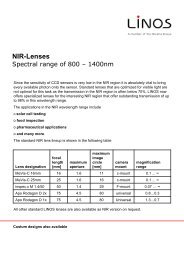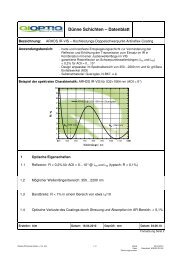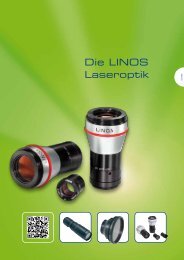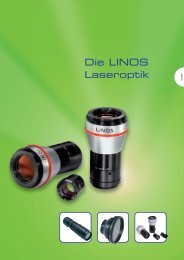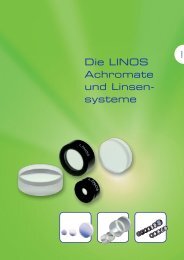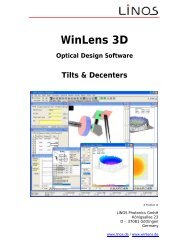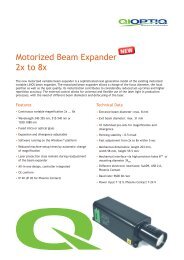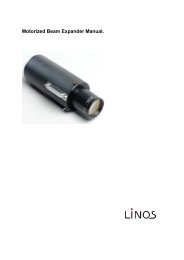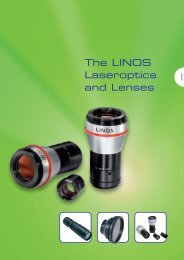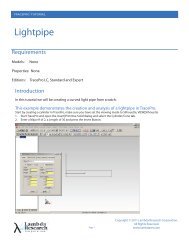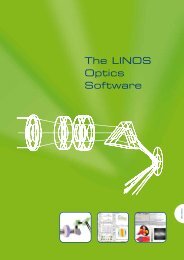08-Optical Tables.pdf - Qioptiq Q-Shop
08-Optical Tables.pdf - Qioptiq Q-Shop
08-Optical Tables.pdf - Qioptiq Q-Shop
You also want an ePaper? Increase the reach of your titles
YUMPU automatically turns print PDFs into web optimized ePapers that Google loves.
Microbench Nanobench Tube System C Positioners Rail Systems Mounts and Posts Mirror Mounts<br />
Support Systems, Introduction<br />
Providing both vertical and horizontal<br />
vibrational isolation<br />
The performance of <strong>Optical</strong> <strong>Tables</strong> is<br />
determined by the performance<br />
characteristics of both their top structures<br />
and their supports, where the<br />
degree of vibrational isolation and the<br />
damping actions provided by the latter<br />
are the major determining factors. High<br />
degrees of vibrational isolation hinder<br />
transmission of building vibrations<br />
through table supports to their top<br />
structures. Strong damping actions<br />
rapidly damp out vibrations of Table Top<br />
structures. Truly effective vibration-isolation<br />
systems must provide both high<br />
degrees of vibrational isolation and<br />
strong damping actions in both vertical<br />
and horizontal planes.<br />
Isolating <strong>Optical</strong> Table Tops from floor<br />
vibrations is a complex problem, since<br />
the directions and amplitudes of floor<br />
vibrations vary with location throughout<br />
buil-dings. On lower floors, they will be<br />
predominantly in the vertical plane. On<br />
upper floors, the amplitudes of floor<br />
vibrations in the horizontal plane<br />
become progres sively worse from floor<br />
to floor.<br />
One figure of merit used in assessing the<br />
effectiveness of damping mechanisms is<br />
their resonant frequency. „Stiffer“<br />
damping mechanisms have higher<br />
resonant fre quencies. Damping mechanisms<br />
damp vibrations star ting at a<br />
frequency 1.4 times their resonant<br />
frequency.<br />
LINOS Photonics and TMC have taken<br />
this into account in desig ning its <strong>Optical</strong><br />
Table support systems, and can thus offer<br />
its customers the following unique<br />
combination of benefits:<br />
Design Features<br />
Table supporting structures consist of a<br />
number of posts, either free-standing or<br />
interconnected by tie-bars, and with or<br />
without vibration-isolation mechanisms<br />
incorporated in their columnar sections.<br />
The types of vibration-isolation systems<br />
required to afford Table Tops adequate<br />
vibrational isolation will depend upon<br />
the experiments planned and ambient<br />
conditions at intended installation sites.<br />
Four different types of support systems<br />
are available<br />
••<br />
Without isolation system (rigid<br />
levelling stand)<br />
••<br />
Passive isolators S<br />
••<br />
Semi-active Gimbal Piston isolation<br />
system<br />
In addition to their outstanding performance,<br />
TMC‘s support systems provide<br />
users the further benefit of modularity.<br />
Any of our vibration-isolation systems<br />
may be readily replaced by, or converted<br />
into, any of the others whenever<br />
required by, e.g., more stringent<br />
demands on the accuracies of experimental<br />
results. Options, such as casters, may<br />
be field-retrofitted whenever needed.<br />
High Quality<br />
Selection<br />
The information needed for selecting<br />
suitable supporting structures are their<br />
load-bearing capacity and the desired<br />
working-surface height. The load<br />
capacity is the addition of the weight of<br />
the table and the maximum total weight<br />
to be carried by the Table Top multiplied<br />
with savety factor 2. Select the post size<br />
that provides the working height you<br />
need, taking into account the table<br />
thickness (has to be substracted).<br />
Ergonomic convention would dictate<br />
910 mm from floor to Table Top surface.<br />
Rigid Stands<br />
Rigid stands provide no vibrational<br />
isolation. Table tops rest on supports<br />
whose heights may be adjusted over a<br />
75 mm range, extending from 25 mm<br />
below their nominal heights, to 50 mm<br />
above their nominal heights.<br />
Rigid stands will be adequate for<br />
supporting relatively simple experimental<br />
setups that are insensitive to vibrations.<br />
Rigid stands are the preferred<br />
choice for our thinner (50 mm or 100 mm<br />
top thickness) Series 77 <strong>Optical</strong> <strong>Tables</strong>.<br />
The special modular design of LINOS and TMC support systems offers<br />
the following advantages:<br />
• Modular construction<br />
• Choice of several damping factors<br />
• Field retrofittability<br />
• Optional struts or footplates<br />
• Excellent vibrational isolation in both vertical and horizontal planes<br />
• Available with/without casters<br />
• Choice of several load-bearing capacities<br />
• Choice of working heights<br />
• Custom and OEM support systems<br />
Retrofits and upgrades can be carried out quickly and easily, because<br />
the standard support systems come equipped with all required bore<br />
holes and threads.<br />
300 Phone numbers: US +1 585 223 2370 UK +44 2380 744 500 Singapore +65 6499 7766



